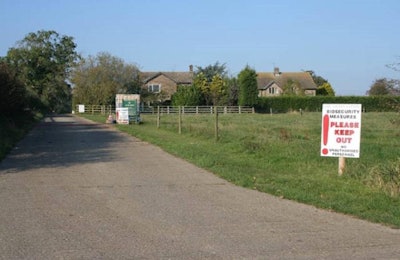
As avian influenza continues to remain a threat in the poultry industry, biosecurity is becoming an ever-greater concern for poultry growers and producers. The recent outbreaks of highly pathogenic avian influenza in the U.S. have underscored the importance of biosecurity.
Dr. Kevin Janni, professor and extension engineer in the Department of Bioproducts and Biosystems Engineering at the University of Minnesota, spoke about the importance of flow analysis in biosecurity at the Midwest Poultry Federation (MPF) Convention in St. Paul, Minnesota, on March 16.
“Flow analysis focuses on the movement of all of the things that need to go in and out of the barn,” said Janni. “When you have a disease outbreak, you need to rethink some of those things.”

Flow analysis is a systemic way to plan, lay out and design facilities and farmsteads to better assess how all of these are moving into, throughout and out of the barn and farm.
Janni shared five critical steps to defining an effective flow analysis:
1) Define barn or farmstead boundaries
Farmstead boundaries can include roads, property lines, gates and fences around a farmstead, whereas barn boundaries define lines of separation between inside and outside the barn (such as a roof, sidewalls, doors, air inlets, air outlets and exhaust fans).
“Every time you have an opening, you have the opportunity for something to get into that opening,” said Janni.
2) Identify every flow that crosses a boundary or line of separation
People, animals, feed, equipment, tools and supplies, rodents and pests, litter, ventilating air, mortalities and personal items such as cell phones must be considered.
“Think about all of the flows that go across that boundary,” said Janni. “One of the challenges is trying to manage mortalities. You’re going to have some, but how do you get them out of the barn?”
3) Describe or track each flow
Various factors must be considered, such as where each item comes from, where and how it gets in, where and how it leaves, and what happens along the way.
4) Assess biosecurity risk of each flow
Biosecurity risks must be identified for each flow, and it’s just as important to consider the costs and benefits of risk management.
“There’s no free lunch,” said Janni. “It’s going to cost you time and energy, and you’ve got to have the supplies to do that.”
5) Develop and implement protocols to manage biosecurity risk
Be sure to consider pre-visit downtime, disinfecting trucks and equipment, boots and coveralls, biosecure entries, handwashing and log books. Danish entry systems, including two-zone entries and three-zone entries, are highly encouraged.

There are a number of challenges associated with implementing effective flow analysis as part of your biosecurity plan.
First, it can be difficult to identify all of the flows, particularly in the case of unusual and rare flows.
“This is not something you’re going to sit down on an afternoon and figure it out,” said Janni.
Second, protocols must be easily implemented to avoid noncompliance. Lengthy or time-consuming protocols are typically abandoned more quickly. For example, well-designed biosecure entries are more likely to result in successful and consistent adaption.
“You’ve got to have it set up so that all employees and anyone else who comes to that site are always gonna have to use it,” he explained. “No sneaking in through the back door.”
Lack of adequate supplies and untrained or uncommitted people are also detrimental to successful implementation of all protocols. Janni recommends reminder signs, simple and inexpensive steps such as a place for people to sit down when taking off their boots and most of all, making it easy for people to implement plans. He also reminded attendees that there’s no single “right” way to implement biosecurity.
“You have to find a way that fits your management style,” he said.

















